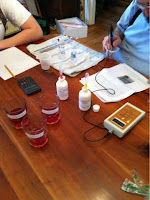 We are still working on bottling our wine from 2012 and we emptied two more carboys today. One was our “plain” apple wine, the other was one of our experimental blackberry varieties. This particular blackberry batch contained a much higher concentration of fruit, but we did not oak it. Rather it is lightly sweet – we just called it bold, to remember that it contained more fruit.
We are still working on bottling our wine from 2012 and we emptied two more carboys today. One was our “plain” apple wine, the other was one of our experimental blackberry varieties. This particular blackberry batch contained a much higher concentration of fruit, but we did not oak it. Rather it is lightly sweet – we just called it bold, to remember that it contained more fruit.
Chronicles of the Long Shot Farm
Wine
Bottling More Wine
 We spent a good part of this weekend (the hottest parts of both days) bottling wine:
We spent a good part of this weekend (the hottest parts of both days) bottling wine:
- Strawberry
- Oaked Chambourcin
- Oaked Blackberry
- Blackberry “Delight”
This was the first time we used our automatic bottle filler, which worked great.
Also sorted more of the empty, washed bottles by color and style. These were then packed into tubs and stored in the barn shelf.
Hoping that this will make some space in the garage – which is really Jeff’s workshop. Organizing all the tools is one of those dream projects for a rainy day….
Wine Bottling
We bottled our first batch of 2012 wine: 5 gallons of Apple and 8 gallons of Chambourcin. I have to say, the wine turned out great. We took measurements of the pH, and SO2 levels, and we were within the perfect range – without having to do much adjusting. Our wines underwent “natural” cold stabilization (with other words, we left all our wine in the downstairs of our unheated stone barn), and the bottom of the carboys had a solid layer of tartrate crystals.
| Tartrate crystals stuck to bottom of carboy |
A note on “Wine Diamonds” (tartrate crystals) – tartaric acid is a normal grape acid. Grapes also contain potassium and under chilly conditions, these two things bind together, forming little potassium bitartrate crystals, which then settle to the bottom of the bottle. They’re completely harmless, and quite natural – but for those people who don’t know what these crystals are, they are seen as impurities or even bits of broken glass. Cold stabilization means that wine is “forced” to form these crystals before it is bottled.
We ran out of colored ink for our printer, so all labels this weekend were done is stark black and white decor. We moved some of the bottles to the barn for storage – hoping the thick stone walls will keep temparatures perfect over the summer as well.
Chemistry Lab in our Dining Room
 Jeff got a wine-testing kit for his birthday – it was like the grown-up version of a little boy getting his first chemistry set. We bought the Vinmetrica combined pH/TA and SO2 analyzer kit and it worked beautifully. The three wines we tested were surprisingly close to ideal ranges for all the readings. Now we have to figure out how to accurately adjust for perfection 🙂
Jeff got a wine-testing kit for his birthday – it was like the grown-up version of a little boy getting his first chemistry set. We bought the Vinmetrica combined pH/TA and SO2 analyzer kit and it worked beautifully. The three wines we tested were surprisingly close to ideal ranges for all the readings. Now we have to figure out how to accurately adjust for perfection 🙂
Experimenting with Labels
I picked up a package of oval “print-to-the-edge” labels that Avery makes. I have to say, they worked great with the templates available from their website. Much, much better than the ones I tried last year. I chose a matte, textured finish 2″ x 3 1/3″ sized white label and had a lot of fun trying out different designs. Actually I spent way too much time “playing” with design options, without realizing how much time had passed. A great option for hobby winemakers 🙂
We used these labels for our last two carboys from 2010 (!)… the wine still tastes great, we just never got around to bottling it until the holiday break. We had 6 gallons of a mixed apple and 5 gallons of a light concord wine.






